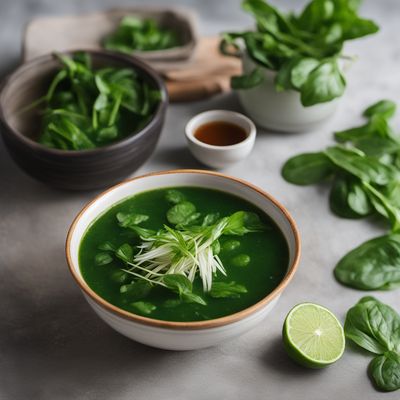
Cuisine
Vietnamese cuisine
Vietnamese cuisine is a balance of sweet, sour, salty, and spicy flavors. It is characterized by its use of fresh herbs, vegetables, and meats. The most popular dishes include pho, banh mi, and spring rolls. Vietnamese cuisine is also known for its use of fish sauce and rice noodles.
Typical ingredients
Rice noodles, Fish sauce, Lemongrass, Ginger, Garlic, Shallots, Star anise, Cinnamon, Mint, Cilantro, Basil, Bean sprouts, Lime, Fish, Pork, Beef, Chicken, Shrimp, Tofu
Presentation and garnishing
Vietnamese dishes are often presented with a balance of colors and textures. Garnishes may include herbs, vegetables, and sauces.
Vietnamese cuisine is known for its use of fresh herbs and vegetables, which are believed to have medicinal properties.
More cuisines from this region...
Thai cuisine, Singaporean cuisine, Malaysian cuisine, Filipino cuisine, Lao cuisine, East Timor cuisine, Cambodian cuisine, Burmese cuisine, Bruneian cuisine, Christmas Island cuisine
History
Vietnamese cuisine has a long history dating back to the 2nd century BC. It has been influenced by Chinese, French, and other Southeast Asian cuisines. During the French colonial period, Vietnamese cuisine was influenced by French cooking techniques and ingredients.
Cultural significance
Vietnamese cuisine is an important part of Vietnamese culture and is often associated with family gatherings and celebrations. It is also a popular street food in Vietnam.
Health benefits and considerations
Vietnamese cuisine is generally considered healthy due to its emphasis on fresh ingredients and minimal use of oil. However, some dishes may be high in sodium or sugar.
Vietnamese cuisine dishes Browse all »

Nem chua
Fermented pork rolls
Nem chua is a traditional Vietnamese dish that is made from fermented pork. It is typically served as a snack or appetizer and is known for its tangy and slightly sour flavor.

Ô mai
Dried fruit
Ô mai is a traditional Vietnamese snack made of dried fruits that are preserved in sugar and spices. It is a sweet and tangy snack that is perfect for snacking on the go or as...

Va tron
Mixed Salad
Va tron is a Vietnamese salad that is made with beef and vegetables. It is a refreshing and healthy dish that is perfect for summer.

Canh bí đao
Pumpkin soup
Canh bí đao is a Vietnamese soup made with winter melon and ground pork. It is a light and refreshing soup that is perfect for hot summer days.

Bì cuốn
Pork skin rolls
Bì cuốn is a Vietnamese dish that is perfect for a light and healthy meal. It consists of thinly sliced pork and fresh herbs wrapped in rice paper.

Cơm tấm
Broken Rice
Cơm tấm is a Vietnamese dish made with broken rice, grilled pork, and various accompaniments. It is a popular street food in Vietnam and is enjoyed by locals and tourists alike.

Bánh mì cá mòi
Vietnamese Sardine Sandwich
Bánh mì cá mòi is a Vietnamese fish sandwich that is typically served as a lunch or dinner option.

Nem phùng
Steamed Pork Dumplings
Nem phùng is a Vietnamese dish that is made with crispy spring rolls. It is a popular appetizer that is often served at parties and gatherings.
Vietnamese cuisine recipes Browse all »

Bánh Trôi - Sweet Glutinous Rice Balls
Heavenly Delights: Sweet Glutinous Rice Balls

Vietnamese Seafood Hot Pot
Oceanic Delight: Vietnamese Seafood Hot Pot

Vietnamese Spinach Soup
Soothing Green Delight: Vietnamese Spinach Soup

Bánh Da Lợn - Vietnamese Pandan Layer Cake
Pandan Delight: A Vibrant Twist to Vietnamese Layer Cake

Vietnamese-style Focaccia
Banh Mi Focaccia: A Fusion of Italian and Vietnamese Flavors

Vietnamese Coconut Sticky Rice (Xôi Dừa)
Coconut Bliss: A Taste of Vietnam's Sticky Rice Delight

Vietnamese Sticky Rice Balls (Cơm Nắm)
Savory Delights: Vietnamese Sticky Rice Balls

Vietnamese Spicy Catfish Hot Pot
Fiery Delight: Vietnamese Spicy Catfish Hot Pot

Vietnamese-style Ceviche
Refreshing Vietnamese Ceviche: A Tangy Delight from the East

Bò Kho - Vietnamese Beef Stew
Hearty Vietnamese Beef Stew: A Burst of Flavors and Aromas

Vietnamese-style Cheesesteak
Banh Mi Cheesesteak: A Fusion of American and Vietnamese Flavors

Vietnamese-style Murgh Malai
Silky Coconut Chicken Curry - A Vietnamese Twist on Murgh Malai